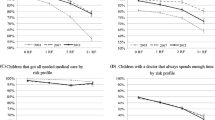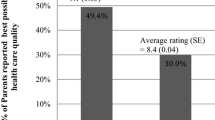Abstract
Objective: To identify characteristics associated with delayed/forgone care for children with special health care needs (CSHCN) in New York State (NYS) as reported by their parents. Methods: Data come from NYS participants in the 2000–2002 National Survey of Children with Special Health Care Needs. Data were analyzed using weighted bivariate and multivariate regression models. The dependent variable was report of delayed/forgone routine health care. Independent variables included illness characteristics, potential and actual access to care, and provider care characteristics. Results: In NYS, 8.4% reported delayed/forgone health care for their child. Parents of children with delayed/forgone care were more likely to report that their child was uninsured (adjusted odds ratio [aOR] 3.8, 95% confidence interval [CI] 1.3–11.8), had experienced interrupted health insurance (aOR 3.9, 95% CI 1.5–9.7), or their child’s insurance was not adequate for CSHCN (aOR 3.6, 95% CI 1.4–9.1). Further, these parents were more likely to report that providers never spend adequate time (aOR 6.3, 95% CI 1.2–34.4), provide sufficient information (aOR 8.0, 95% CI 2.5–25.0), act as partners in care (aOR 6.7, 95% CI 2.3–19.7), or display cultural sensitivity (aOR 5.4, 95% CI 1.2–24.3). Conclusions: An estimated 40,771 NYS CSHCN experience delayed/forgone routine health care. Their families report two noteworthy barriers: inadequate or discontinuous insurance coverage and poor communication with health-care providers. Access to care for CSHCN can be improved by increasing consistent comprehensive insurance coverage and increasing sensitivity in relationships between health care providers and families of CSHCN.
Similar content being viewed by others
References
New York State Maternal and Child Health Services Title V Block Grant Program. 2005 Application; 2003 2003 Annual Report.
Seid M, Sobo EJ, Gelhard LR, Varni JW. Parents’ reports of barriers to care for children with special health care needs: Development and validation of the barriers to care questionnaire. Ambul. Pediatr. 2004;4(4):323–31.
Strickland B, McPherson M, Weissman G, van Dyck P, Huang ZJ, Newacheck P. Access to the medical home: Results of the National Survey of Children with Special Health Care Needs. Pediatrics 2004;113(5):1485–92.
Newacheck PW, Strickland B, Shonkoff JP, Perrin JM, McPherson M, McManus M, Lauver C, Fox H, Arango P. An epidemiologic profile of children with special health care needs. Pediatrics 1998;102(1):117–23.
Newacheck PW, McManus M, Fox HB, Hung YY, Halfon N. Access to health care for children with special health care needs. Pediatrics 2000;105(4):760–66.
State Profile of New York: Data from the 2002 National Survey of America’s Families. 2004. (online)Available at: http://www.urban.org/UploadedPDF/900724_nyprofile_web.pdf.
Mayer ML, Skinner AC, Slifkin RT. Unmet need for routine and specialty care: Data from the National Survey of Children With Special Health Care Needs. Pediatrics 2004;113(2):e109–15.
Starfield B, Shi L. The medical home, access to care, and insurance: A review of evidence. Pediatrics 2004;113(5 Suppl):1493–98.
Kogan MD, Alexander GR, Teitelbaum MA, Jack BW, Kotelchuck M, Pappas G. The effect of gaps in health insurance on continuity of a regular source of care among preschool-aged children in the United States. JAMA 1995;274(18):1429–35.
Newacheck PW, Hung YY, Wright KK. Racial and ethnic disparities in access to care for children with special health care needs. Ambul. Pediatr. 2002;2(4):247–54.
Ziring PR, Brazdziunas D, Cooley WC, Kastner TA, Kummer ME, Gonzalez de Pijem L, Quint RD, Ruppert ES, Sandler AD, Anderson WC, Arango P, Burgan P, Garner C, McPherson M, Michand L, Yeargin-Allsopp M, Johnson CP, Wheeler LS, Nackashi J, Perrin JM. American Academy of Pediatrics. Committee on Children With Disabilities. Care coordination: Integrating health and related systems of care for children with special health care needs. Pediatrics 1999;104(4 Pt 1):978–81.
Design and operation of the national survey of children with special health care needs: Program and collection procedures. Hyattsville, Maryland; 2001 June 2003. Report No.: Series 1, Number 41.
Shone LP, Dick AW, Brach C, Kimminau KS, LaClair BJ, Shenkman EA, Col JF, Schaffer VA, Mulvihill F, Szilagyi, PG, Klein JD, Van Landeghem K, Bronstein J. The role of race and ethnicity in the State Children’s Health Insurance Program (SCHIP) in four states: Are there baseline disparities, and what do they mean for SCHIP? Pediatrics 2003;112(6):e521.
Newacheck PW, Kim SE. A national profile of health care utilization and expenditures for children with special health care needs. Arch. Pediatr. Adolesc. Med. 2005;159(1):10–7.
Brach C, Lewit EM, VanLandeghem K, Bronstein J, Dick AW, Kimminau KS, LaClair B, Shenkman E, Shone LP, Swigonski N, Szilagyi PG. Who’s enrolled in the State Children’s Health Insurance Program (SCHIP)? An overview of findings from the Child Health Insurance Research Initiative (CHIRI). Pediatrics 2003;112(6):e499.
Szilagyi PG, Shenkman E, Brach C, LaClair BJ, Swigonski N, Dick A, Shone LP, Schaffer VA, Col JF, Eckert G, Klein JD, Lewit EM. Children with special health care needs enrolled in the State Children’s Health Insurance Program (SCHIP): patient characteristics and health care needs. Pediatrics 2003;112(6 Pt 2):e508.
America’s Health: State Health Rankings. 2004. (online) Available at: http://www.unitedhealthfoundation.org/shr2004/.
National Conference of State Legislatures. State Children’s Health Insurance Program (SCHIP): A Snapshot of State Action. (online) Available at: http://www.ncsl.org/programs/health/update.htm.
Dick AW, Klein JD, Shone LP, Zwanziger J, Yu H, Szilagyi PG. The evolution of the State Children’s Health Insurance Program (SCHIP) in New York: Changing program features and enrollee characteristics. Pediatrics 2003;112(6):e542.
Hill I, Stockdale H, Courtot B. Squeezing SCHIP: States use flexibility to respond to the ongoing budget crisis. Washington, DC: The Urban Institute; 2004 June 2004. Report No.: Series A, No. A-65.
Ku L, Nimalendran S. Losing out: States are cutting 1.2 to 1.6 million low-income people from Medicaid, SCHIP and other state health insurance programs: Center on Budget and Policy Priorities; 2003 Dec. 22, 2003.
Author information
Authors and Affiliations
Corresponding author
Rights and permissions
About this article
Cite this article
Smaldone, A., Honig, J. & Byrne, M.W. Delayed and Forgone Care for Children with Special Health Care Needs in New York State. Matern Child Health J 9 (Suppl 2), S75–S86 (2005). https://doi.org/10.1007/s10995-005-3859-9
Issue Date:
DOI: https://doi.org/10.1007/s10995-005-3859-9




